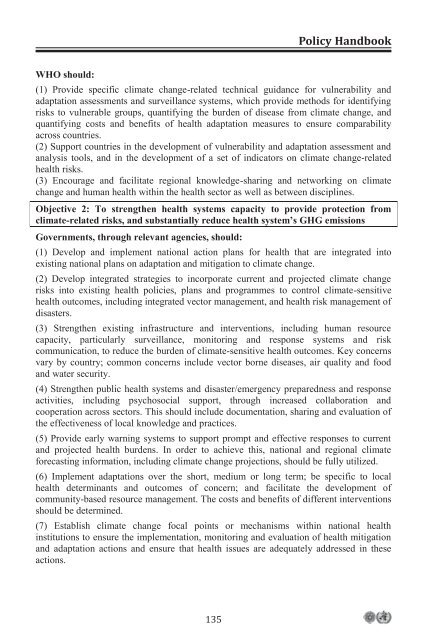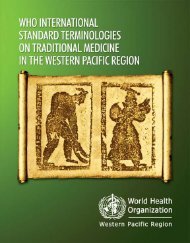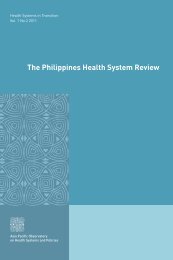Untitled - DOH
Untitled - DOH
Untitled - DOH
- No tags were found...
You also want an ePaper? Increase the reach of your titles
YUMPU automatically turns print PDFs into web optimized ePapers that Google loves.
Regional Framework for Action to Protect Human Health fromEffects of Climate ChangePolicy HandbookWHO should:(1) Provide specific climate change-related technical guidance for vulnerability andadaptation assessments and surveillance systems, which provide methods for identifyingrisks to vulnerable groups, quantifying the burden of disease from climate change, andquantifying costs and benefits of health adaptation measures to ensure comparabilityacross countries.(2) Support countries in the development of vulnerability and adaptation assessment andanalysis tools, and in the development of a set of indicators on climate change-relatedhealth risks.(3) Encourage and facilitate regional knowledge-sharing and networking on climatechange and human health within the health sector as well as between disciplines.Objective 2: To strengthen health systems capacity to provide protection fromclimate-related risks, and substantially reduce health system’s GHG emissionsGovernments, through relevant agencies, should:(1) Develop and implement national action plans for health that are integrated intoexisting national plans on adaptation and mitigation to climate change.(2) Develop integrated strategies to incorporate current and projected climate changerisks into existing health policies, plans and programmes to control climate-sensitivehealth outcomes, including integrated vector management, and health risk management ofdisasters.(3) Strengthen existing infrastructure and interventions, including human resourcecapacity, particularly surveillance, monitoring and response systems and riskcommunication, to reduce the burden of climate-sensitive health outcomes. Key concernsvary by country; common concerns include vector borne diseases, air quality and foodand water security.(4) Strengthen public health systems and disaster/emergency preparedness and responseactivities, including psychosocial support, through increased collaboration andcooperation across sectors. This should include documentation, sharing and evaluation ofthe effectiveness of local knowledge and practices.(5) Provide early warning systems to support prompt and effective responses to currentand projected health burdens. In order to achieve this, national and regional climateforecasting information, including climate change projections, should be fully utilized.(6) Implement adaptations over the short, medium or long term; be specific to localhealth determinants and outcomes of concern; and facilitate the development ofcommunity-based resource management. The costs and benefits of different interventionsshould be determined.(7) Establish climate change focal points or mechanisms within national healthinstitutions to ensure the implementation, monitoring and evaluation of health mitigationand adaptation actions and ensure that health issues are adequately addressed in theseactions.135135
















